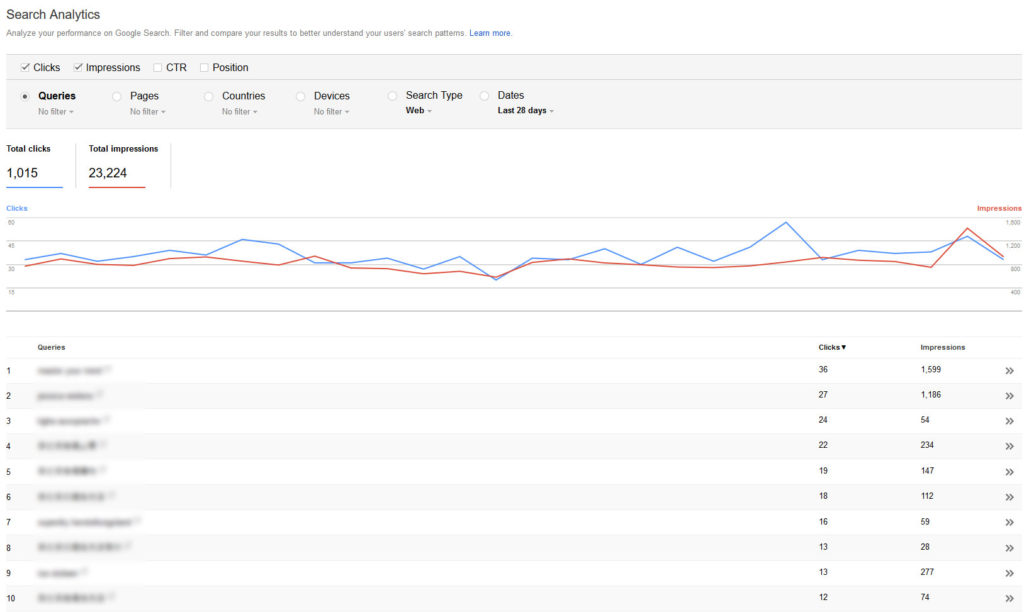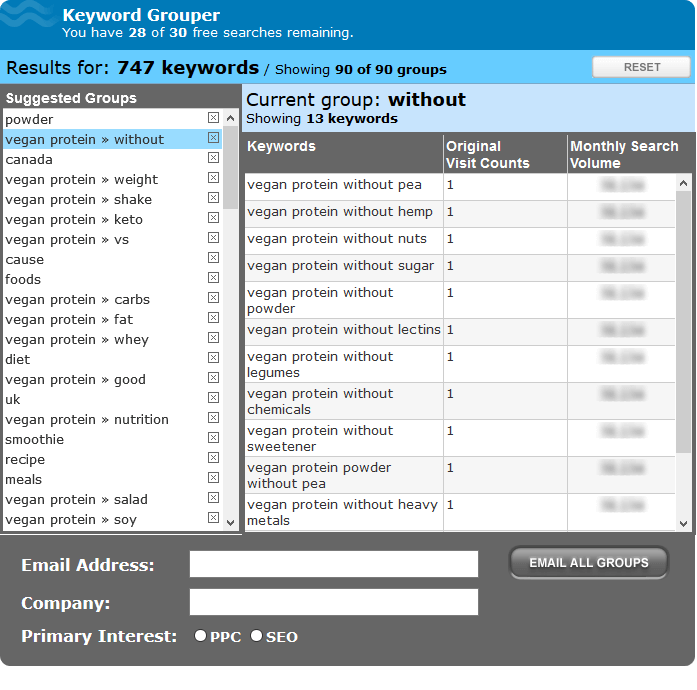Keyword clustering is an excellent SEO tool. If your pages fail to gain traction in search engines and don’t bring in the amount of visitors you wanted, grouping keywords is a great way to improve upon this situation. It can also help you improve your site in general.
In the following blog post, we will define what it is and how it can benefit your site. After that, we will show you how to apply this technique in order to gain its benefits.
Let’s get started right away.
What is Keyword Clustering (And Why Should You Care)?
As a first step, let’s define what exactly what we are talking about.
Grouping Keywords Allows You to Target More Than One Keyphrase Per Page
Most of the time, when doing keyword research, you are aiming to end up with one main keyword to target with each of your pages. In fact, Yoast SEO is set up in this way and asks you to set up a focus keyphrase when creating content.

(In the premium edition, you also have the ability to target synonyms and related key phrases.)
However, this flies in the face of the reality that web pages usually rank for more than one keyword. Just have a look at your Google Search Console (under Performance) and you can easily see for yourself.

So, instead of doing the usual, keyword clustering means putting together a whole list of keywords to target with a blog post and not just one focus keyphrase.
Grouping Keywords Offers Many Benefits
The above sounds like a bunch of effort, right? So, why would you do that for yourself?
Well, as stated in our post on outdated SEO strategies, the practice of targeting one keyword variation per page is a bit anachronistic. It used to be a good method in the early days of Google and many people employed is successfully to build microsites.

However, in times where you need to create content for readers, not search spiders, the search engine has become much better at understanding context, synonyms, and related topics. As a consequence, it will rank pages for whole hosts of keywords, not just single phrases.
Since this is happening anyway, why not take advantage of it and create content exactly with that goal in mind? That way, you increase your chances of being visible for many search queries, meaning more chances people will click on your articles and come to your site. Who says no to that?
How to Put Keyword Clustering into Practice
If you are intrigued by the above, by now you are probably itching to figure out how to apply this technique to your WordPress site. No worries young padawan, that is exactly what we will go through for the rest of the article. (Is padawan still a relevant cultural reference in 2019 or am I getting old?)
1. Collect Keywords
As you will see below, there are several ways to do keyword clustering. However, what they all have in common is that you first need a selection of key phrases to create clusters from. Therefore, the initial step of using this SEO technique is classic keyword research (here is our article on that topic again).
For those who don’t want to read an entire post, here are a number of excellent sources to glean this kind of information from:
- Brainstorming keywords based on your site, audience, and industry
- Competitor analysis and market research
- SEO tools (e.g. AnswerThePublic, Keywordtool.io)
- Information in Google Search Console and Google Analytics
The important thing at this stage is to go for quantity not quality. It’s better to have a wide set of keywords from which you can eliminate irrelevant entries than to start from a limited data set.
How much is enough? However many you can find, but several hundred to a thousand is a good starting point. It can also be a lot more. Your goal is to make a complete sweep so you never have to do it again.
Once you are satisfied, it’s time to start grouping them into clusters that make sense. As mentioned, here you have several possibilities.
2.1 Manually Create Keyword Groupings
One of the ways to go from a long list of keywords to topical clusters is to do create them manually. By that, I don’t suggest that you go through several thousand keyword possibilities one by one and categorize them by hand. Instead, you can do some old-school SEO work and use a spreadsheet.
Tom Casano describes a detailed way to do this over on the Moz blog. It involves the following steps:
- Running your keyword list through a word and phrase frequency counter to find the most-used search components
- Figuring out the most important terms and phrases to create topical groups
- Assigning your search phrases by topic to create keyword clusters
The whole thing involves a whole bunch of spreadsheet trickery and formulas. However, it is a great way to whittle down your search phrases by hand and I recommend you check the original article.
2.2 Use a Free Keyword-Clustering Tool
While the above is great to get your hands dirty and really understand the process, it’s not the only possibility. There are a number of tools out there that can group your keywords automatically. All you need to do is feed them your list and the rest happens by itself.
The best free solution that I have found is the WordStream Keyword Grouper.

It offers you 30 free searches initially and one per day once you have used up your quota. Simply copy and paste your list of keywords in there and then hit the button on the bottom right. You will end up with something like this.

In my test, the results were pretty good. From my seed keyword group based on vegan protein, I got several clusters that would make great content pieces or pages. You can also remove any group from the results that don’t make sense by clicking the X. That way, you end up only with those that are helpful. Plus, the tool will email you the full list if you wish.
2.3 Use a Paid Tool
Of course, where there are free tools, there are also paid versions. Besides unlimited usage rights, many of them also come with other features to improve your SEO. Here are a number of great options:
- Topvisor — This is an SEO suite for all sorts of purposes. It comes with a rank tracker, keyword research, auditing tool and a whole lot of other features. The keyword clustering tool offers a free trial and uses Google’s top results to find related keywords based on the URLs they appear in. After the trial, pricing starts at $0.8 per 100 keywords.
- WordStream — The above-mentioned WordStream also has more to offer than the free keyword clustering tool. They mostly concentrate on running PPC campaigns and help with analysis and optimization. If that is your thing, pricing starts at $20/month.
- SpySerp — SpySerp is a keyword rank tracker that works both for Google and Bing. Their tools include a keyword grouping feature that you can try for free. After that, they have different plans that start at $19/month.
- Serpstat — This option has a keyword clustering tool that uses real-life data from Google for grouping keyphrases. Aside from that, you get keyword research, search analytics, rank tracking, site auditing and a lot more. You can get started for $19 a month for a personal plan. There is also a free trial for the entire suite.
- SE Ranking — Similar to the above, here you feed your keyword collection into its grouping tool, set your filtering options (country, search engines, language, accuracy) and it will get to work. SE Ranking also has a free trial. If you sign up, you get access to their other SEO tools (rank tracking, competitor research, backlink monitoring and more). Plans start at $5/month.
- SpyFu — The final entry is a competitor research tool that also has SEO features. Among them is a keyword clustering tool that you can test for 30 days. Paid memberships start at $33/month.
As you can see, many of these offer the possibility to test them for free. Therefore, if you want to get serious about your keyword clustering, you can give them a thorough test run before committing. Plus, they might offer other things you need.
3. Put Your Keyword Groups to Good Use
Alright, now that you have clusters of keywords, what do you do with them? Does that mean you need to use all of them in your next post?
No, that’s not entirely the idea. While it can certainly make sense to a certain degree, chances are that if you force yourself to use all the words in one cluster, it will result in an unreadable mess.
Instead, the groups are there to inform your choices about what content to create and changes to make about your site. They point out concepts and topical areas that are potentially missing from but that users are interested in. With that, you can do the following:
- Create new content — The easiest way to use keyword clusters is to take them as jumping off points for content pieces. Pieces that, if you play your cards right, will target dozens of keyword phrases instead of just one. However, as mentioned, you don’t need to use every single phrase in a cluster. Instead, use the most important ones and let the others guide you in which information to include to best help your users.
- Update existing content — Alternatively, you are also able to apply keyword groupings to existing content pieces in order to give them a well-deserved SEO boost. See if there are keywords that you are not using at all and that could make sense to include. You might even add entirely new sections. Also, make sure to add your new keyphrases in important places for on-page SEO.
- Improve your site structure — Finally, you can use keyword clusters to analyze your website from a higher level and see if something is missing. Groupings might give you ideas for additional pages to include, taxonomy to add or topical areas to explore.
So, in short: Use keyword clustering to fill in any holes that you might make out in your content and how you cover your topics.
Grouping Keywords – The Long and the Short of It
Keyword clustering is an interesting concept to improve the ranking ability of your posts and pages. It allows you to take advantage of the way Google approaches search these days. Instead of targeting a narrow keyphrase, you can go for an entire topical area and cover a wide range of information users seek out in the process.
Doing this is nothing new. It’s advice that has actually been around for a while.
If you pay attention to create well-researched and well-written content pieces, you will automatically target many keywords through synonyms and talking about related topics. Keyword clustering just helps you approach this more methodically and maybe lets you uncover keyphrases you usually wouldn’t. Plus, it helps you better understand your audience and niche.
Above, we have given you ways to create keyword groupings for your own website. If you engage in keyword clustering the right way, it has the potential to yield you lots more in traffic than classic on-page optimization. Together with technical SEO and other optimization techniques, there is no reason to keep your site from dominating the search results.
Do you have experience with keyword clustering and would like to share it? Any tips on how to find relevant keyword groupings more easily? Let us know in the comments section below!
The post Keyword Clustering – What It Is and Why You Need to Do It (+Tools!) appeared first on Torque.
